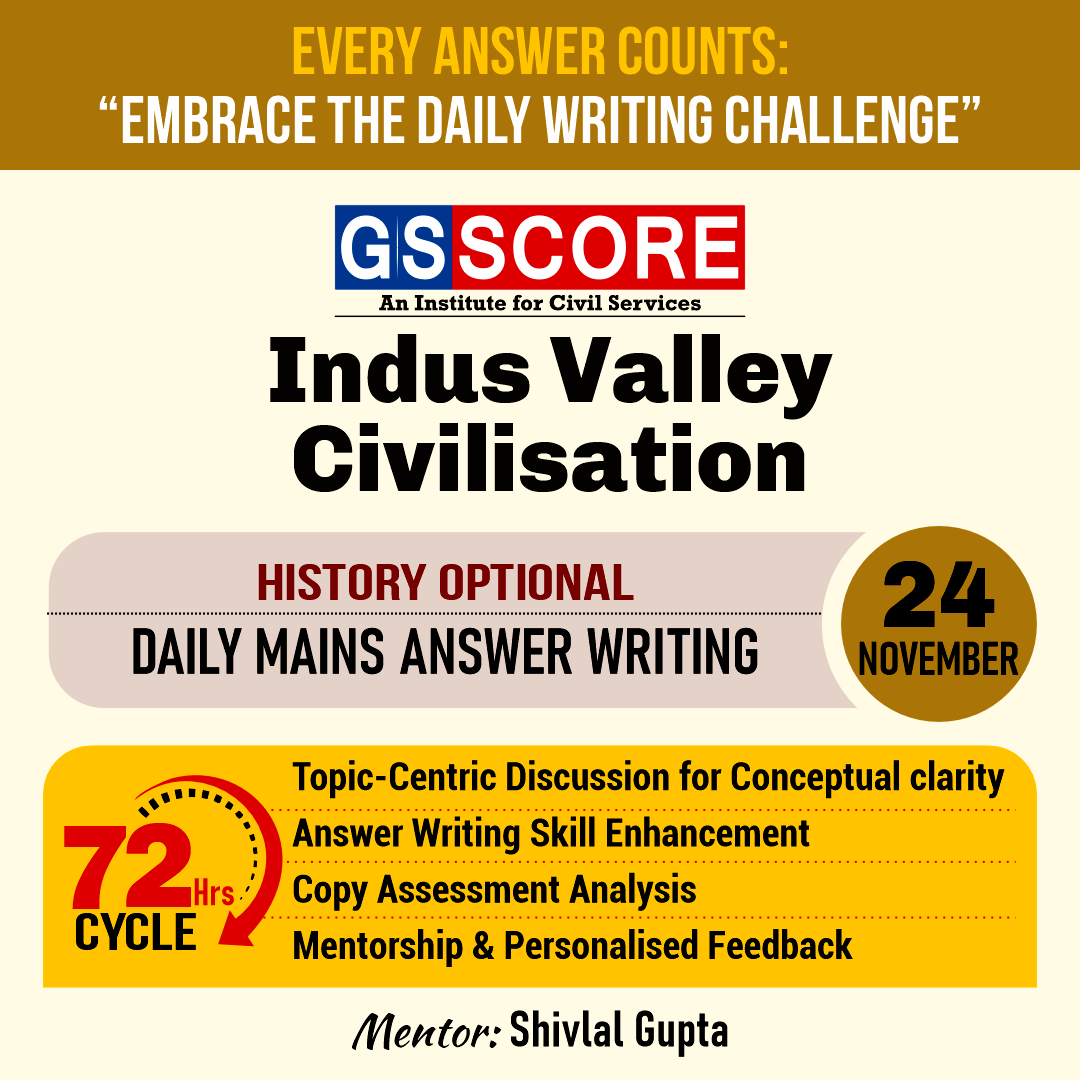


Instruction:
- There will be 2 questions carrying the First Question is-10 marks Write your answers in 150 words and the Second Question is-15 marks Write your answers in 250 words.
- Any page left blank in the answer-book must be crossed out clearly.
- Evaluated Copy will be re-uploaded on the same thread after 2 days of uploading the copy.
- Discussion of the question and one to one answer improvement session of evaluated copies will be conducted through Google Meet with concerned faculty. You will be informed via mail or SMS for the discussion.
Question #1. Discuss the characteristic features of Indus Civilization with special reference to Town planning of Harappan culture. 10 marks (150 words)
Question #2. Delineate various contrasting theories on the origin of Harappan Civilization along with their limitations. (20 Marks) 15 marks (250 words)
(Examiner will pay special attention to the candidate's grasp of his/her material, its relevance to the subject chosen, and to his/ her ability to think constructively and to present his/her ideas concisely, logically and effectively).
STEPS & INSTRUCTIONS for uploading the answers
Step 1 - The Question for the day is provided below these instructions. It will be available at 7:00 AM.
Step 2 - Uploading of Answers : Write the answer in A4 Sheet leaving proper margins for comments and feedback and upload the PDF in MY ACCOUNT section. Click on the option of SUBMIT COPY to upload the PDF.
Step 3 - Deadline for Uploading Answers: The students shall upload their answers by 7:00 PM in the evening same day. The first 50 copies will be evaluated.
Step 4 - Feedback : Mentors will give their feedback for the answers uploaded. For more personalised feedback, join our telegram channel by clicking on the link https://t.me/mains_answer_writing_cse . A one-to-one session will be conducted with the faculty after copy evaluation in 72 Hrs.
Model Answer
Question #1. Discuss the characteristic features of Indus Civilization with special reference to Town planning of Harappan culture. 10 marks (150 words)
Approach:
- Define what civilization is
- Characteristics of civilization
- Features of harappan civilization with special reference to town planning of Harappa
- Criticism based on later observations
- Conclusion
Hints:
According to Ogburn and Nimkoff, civilization is the latter phase of superorganic culture. Such a culmination was seen in the post Neolithic period which was characterized by the rise of Bronze age civilizations throughout the world.
According to V. Gordon Childe, the 10 criteria of a civilization are:
- Foreign trade,
- increased settlement size,
- Writing, political organization based on residence rather than kinship,
- Class-stratified society,
- Representational art,
- Full-time specialists in non-subsistence activities,
- Knowledge of science and engineering,
- Large-scale public works and
- Concentration of wealth.
- Childe also coined the term “urban revolution,” a phenomenon caused by growth of technology and increased food supplies.
Features of Harappa civilization:
- Range of Urban and Non-urban sites.
- Town Planning with defensive Walls and impressive gates (read town planning features from 1st answer)
- Divisions of settlements (upper citadel and lower town)
- Excavation of graves show the class stratification with some graves buried with precious stones, bronze implements, etc.
- Drains- civic sense
- Baked bricks 4:2:1
- Pottery- baked; utilitarian purpose- storage of grains- It shows presence of a surplus.
- Script- writing on the seals; boustrophedon
- Craft techniques- terracotta figurines, bearded priest, dancing girl
- Etched Carnelian beads, copper-bronze artefacts, lithic blades
- Seals
- Weights and Measures- a uniform standard was evolved
- External trade- Indus valley civilization has been termed as Meluhha in the records of Mesopotamian civilization.
- Evidence of big granaries in Harappa- redistribution of grains- shows the presence of a political authority
Town planning
The Harappan culture was a Bronze Age civilization that existed in the north-west region of Indian subcontinent around 2500 to 1800 BC. Its many aspects were studied by archaeologists like DayaramSahni, Mortimer Wheeler, RD Bannerji, Alexander Cunningham etc who brought forth the urban aspects of the Harappan culture.
Illustration:
- Grid pattern: Roads cut each other at 90 degree angles
- Standardized bricks: The bricks are baked and all bricks corresponded to sizes in a perfect ratio of 4:2:1
- Defense Walls and fortifications around many cities
- Most of the cities were divided into 2 parts- the upper town and the lower town
– Citadel- Rulers
– Lower Town- Commoners
- Privacy was an important value for the harappan people. The doorways and windows opened on the sideways instead of the main street.
- There was a robust and watertight drainage system with small house drains connected to a large severage drain which dumped the sludge outside the city walls.
- There were separate toilets and bathing spaces in the houses.
Criticism:
Such planned features weren’t universally found throughout the Indus valley civilization and were limited to a few cities only.
For ex:
- Lothal and Chanudharo had no fortifications
- Kalibangan suffers from little use of burnt bricks, civic drainage and wells.
- At lothal, the streets varied in width at many places
Conclusion: Even though the urban features were not widespread, one cannot deny that the Harappan civilization had a civic sense, four millennia before the advent of actual modernity.
Question #2. Delineate various contrasting theories on the origin of Harappan Civilization along with their limitations. (20 Marks) 15 marks (250 words)
Approach
- Demand of the question is straight forward where the introduction shall highlight the importance of theories of origin in order to understand the civilisation in a better way.
- Discuss the different theories along with their limitations
- Suggest a way forward due to excavations are an ongoing practice.
- Conclude with brining balance and sum-up of your arguments.
Hints
Origin of Harappan Civilization the Indus or Harappan culture arose in the north-western part of the Indian subcontinent. This was discovered first in 1921 at the modern site of Harappa, situated in the province of west Punjab in Pakistan. Hence it is called Harappan civilization.
It is also called as Indus civilisation because it refers to precisely the same cultural, chronological and geographic entity confined to the geographic bounds of the Indus valley. Extensive excavation work was conducted at Mehrgarh near the Bolan Pass between 1973 and 1980.
The origin of Indus valley was like a historical puzzle and there are many views regarding it. Some of the prominent ones are Diffusionist and indigenous theory.
- Diffusionist Theory
- E.J.H. Mackay, D.H. Gordon and S.N. Kramer supported this view.
- According to them, migration of people from Sumer (Southern Mesopotamia) may have led to the evolution of the Harappan civilization.
- M. Wheeler argued that it was not migration of people but migration of ideas the idea of civilization from West Asia that led to growth of Harappan civilization. He also accepted the outside links. But there are several difference between Harappan and Mesopotamian civilisation.
- Diffusionist theories were popular among archaeologists and historians in the 19th and early 20th century.
Criticism of the theory
- The flawed assumptions like similar discoveries in different parts of the world are concomitant to each other, the stress on superficial resemblance and ignoring the striking differences etc. put a question mark on the Diffusionist Theory.
- According to Upinder singh, In case of Indus Valley Civilisation, although Mesopotamian civilization was earlier than Harappan, but striking differences like script, different settlement layouts greater use of bronze and canal systems in Mesopotamia highlight the loopholes of this theory to the surface. The difference in shapes of seals, splendid tomb of Mesopotamia, tolls and weapons was also another factor too glaring to be missed.
- Indigenous Origin
- The origin of Harappan civilization can be traced to the emergence of settled farming communities in Baluchistan and Sind, Rajasthan and Punjab which evolved into pre Harappan phase and later matured into Harappan civilization.
According to Indigenous Origin theory, the Harappan Civilisation evolved in four phases.
(a) Pre Harappan(600-3500BC): Mehrgarh and Kili Ghul Muhammad.
(b) Early Harappan (3500-2600BC): Transition phase-Amri, Kotdiji, Kalibangan.
(c) Mature Harappan phase: (2600-1900BC) Harappa, Mohenjo-daro, Kalibangan, Dhaulavira etc.
(d) Late Harappan Phase: (1900-1300BC).
- Archaeologists like Amlendu Ghosh and M.R. Mughal tried to study the similarities between the pre-Harappan and mature Harappan culture and proved this view.
- Linkages of Harappan culture with pre-harappan was propounded in explanation sothi culture of Rajasthan. Amlendu Ghosh elaborated it and said that some say it Baluchi culture like Zhoab, Quetta, Nal &Kuli culture as origin.
- They brought similarities in pottery, settlement pattern, specialization in craft making, use of wheeled transport and similar raw materials (except jade, which was used in mature phase only). The difference was only in size of cities and number of specialized fields, which shows the Pre-Harappan phase later evolved into mature Harappan culture.
- The essential basis for mature urbanism must be seen as the gradual build-up of population and its spread through the Indus plains, the growth of technology and agricultural know-how; establishment of socio-economic interaction spread over an enormous area, which started in early Harappan phase and led to mature urban culture.
- Sites providing cultural continuity to mature harappan are Banawali and Kunal, Bhirana (haryna).
Thus looking at broader and dynamic nature of debates we can say that the Origin is still complex. Most historians now accept and agreed on the point that emergence of harappan civilisation, cities was preceded by a long period of evolution.


